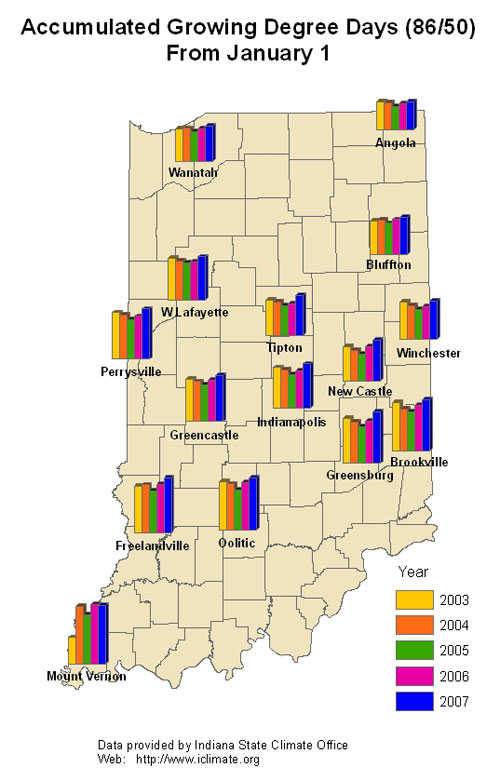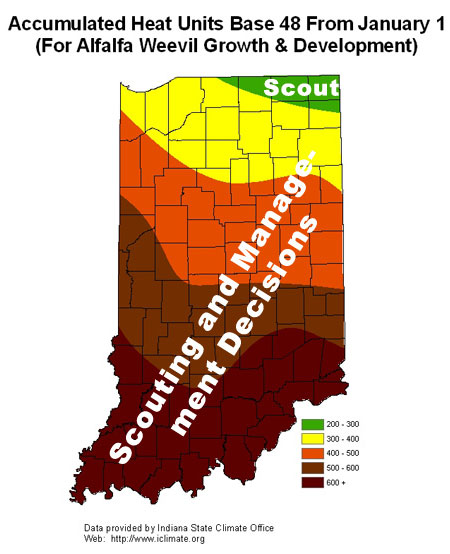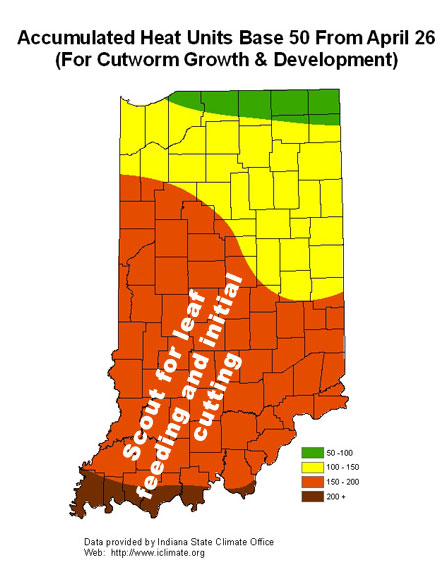Pest & Crop Newsletter, Entomology Extension, Purdue University
- Soybean Aphid, A New Beginning for 2007
- Don't Neglect Alfalfa Fields
- Accumulated Heat Units Base 48
- Black Cutworm Scouting Should Begin
- Accumulated Heat Units Base 50
- Black Cutworm Adult Pheromone Trap Report
- Black Light Trap Catch Report
![]()
Soybean Aphid, A New Beginning for 2007 – (Christian Krupke, John Obermeyer, and Robert O’Neil)
- Last fall’s huge population has seemingly crashed.
- Mid-summer invasion is our greatest threat.
- Scouting and using treatment thresholds are encouraged.
Last fall we had a tremendous migration of soybean aphid from maturing soybean to its overwintering host buckthorn for egg laying. This led to the possibility of early-season infestations and damage to the soybean crop, something we’ve not experienced before in Indiana. Fortunately, weather was on our side this spring, and seems to have diminished the eggs and/or newly hatched aphids to “normal” levels – that is, levels that we have seen in other outbreak years, specifically 2005. So, the 2007 season begins with a clean slate concerning soybean aphid and their threat.
Researchers from Purdue University and the University of Illinois took a “tour” of known buckthorn patches in Illinois, Indiana and Ohio last week. After last fall’s tremendous population, they were surprised to find relatively low numbers of aphids on buckthorn. It is not certain whether the early April freeze killed hatched aphids or (more likely) that the buckthorn leaves were killed during the spring cold snap, eliminating food for the newly hatched aphids, which require a constant supply of growing foliage to survive.
Although the aphid numbers have been reduced for this spring’s Indiana soybean invasion, we understand how quickly this pest can populate and damage the crop. More importantly, mass movement of winged aphids to Indiana from the upper Midwest during later July/early August has been, and continues to be, our primary concern. This pattern of aphid invasion, from locations of high infestation, is what occurred in 2003 and 2005. Scouting is still critical for this insect, especially during the soybean’s early reproductive stages. Stay tuned for future developments with this insect pest. Happy scouting!
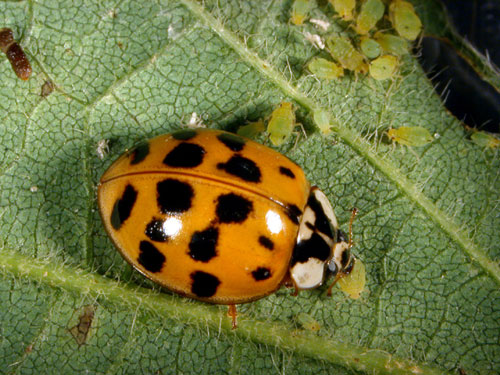
Lady beetle aphid feast on buckthorn
![]()
Don’t Neglect Alfalfa Fields – (Christian Krupke, John Obermeyer, and Larry Bledsoe)
- Scout alfalfa NOW for weevil damage!!!
- Warm temperatures have accelerated larval development and activity.
Alfalfa fields in southern and central Indiana need to be inspected immediately for weevil tip feeding and skeletonization of leaves. Understandably this is a difficult time commitment with planting of corn and soybean going full bore. Use the following heat unit map to determine the proper management action for your area of the state. See Pest&Crop #5, April 27, 2007, treatment guidelines and recommended insecticides.
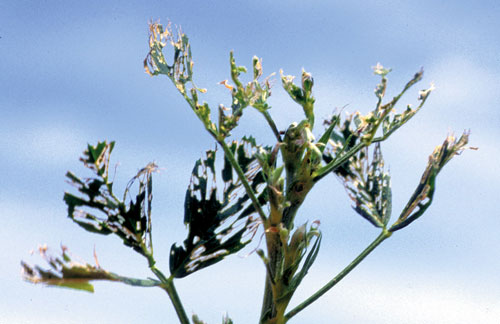
Don't let weevil damage get this bad
![]()
Black Cutworm Scouting Should Begin – (Christian Krupke, John Obermeyer, and Larry Bledsoe)
- Southern Indiana should be looking for leaf feeding and initial cutting.
- Scouting and management guidelines given below.
- Rotary hoe may improve control where soil soils are dry.
A few reports of cutworm leaf-feeding damage have been received from southern Indiana. Black cutworm moth catches in pheromone traps have indicated several intensive flights into the state during the storm system that moved through in late April. We have begun to track heat unit accumulations from those significant flights to predict black cutworm development and beginning of plant cutting approximately 300 HU50, see following map. Monitoring for black cutworm cutting should begin in southern counties.
Scout by inspecting 20 consecutive plants in each of 5 areas of a field (100 plants) for cutworms and feeding activity. Count and record the number of plants cut or damaged and determine the percentage of plants affected. Also collect black cutworm larvae (usually found near the damage, just beneath the surface during the day) and determine the average instar stage. While sampling, also record how many leaves are fully unrolled (the collar of the leaf is visible on a fully unrolled leaf). Control of black cutworm may be necessary if 3 to 5% of the plants are damaged and the average larval instar is from 4 to 6. An instar guide is available inside the back cover of the Corn and Soybean Field Guide.
To increase the probability that adequate control will be achieved when dry soil conditions are noted, a rotary hoe may prove useful. This should stir up the soil and increase the likelihood that the cutworms will come in contact with the insecticide. Additionally, the use of a higher rate of the insecticide in 20 gallons or more water per acre may help the level of control. On no-till fields, where hoeing is not possible, applying the insecticide in the early evening may increase control, as the caterpillars move toward the soil surface during the nighttime hours.
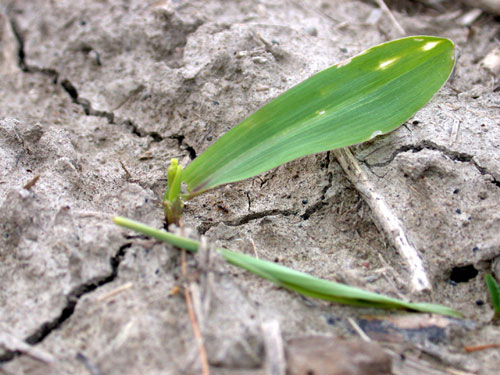
Early black cutworm cutting
| Black Cutworm Management Guidelines | ||||||
| Average Instar of BCW | 6 or more | Number of Plant Leaves Fully Emerged | ||||
| 5 | 4 | 3 | 2 | 1 | ||
| 4.0 | 1%+ | 2%+ | 2%+ | 2%+ | 3%+ | 4%+ |
| 5.0 | 2%+ | 3%+ | 4%+ | 4%+ | 6%+ | 25%+ |
| 6.0 | 4%+ | 7%+ | 9%+ | 17%+ | Don't | Don't |
| 7.0 | 6%+ | 15%+ | 50%+ | Don't | Don't | Don't |
| 1. Look down the column at the left labeled “Average Instar of BCW” until you find the average instar of BCW found in the field. This column is called the Instar Row. Refer to the Corn and Soybean Field Guide for an instar guide. 2. Look across the top of the table and find the number that best represents the “Number of Plant Leaves Fully Emerged” for the plants inspected. A leaf is fully emerged if the leaf collar is visible. The column of figures below this is called the Leaf Column. 3. Follow the Instar Row and the Leaf Column to the place where they intersect. This figure is the control threshold. If the percentage of cut or damaged plants in the field equals or exceeds this number, treatment may be advisable. |
||||||
![]()
Click here to view the
Black Light Trap Catch Report - (John Obermeyer)
Freeze and Rain Damaged Glyphosate Resistant Corn Receives Crisis Exemption - (Indiana State Chemist and Seed Commissioner)
The freezing temperatures that Indiana experienced during April 2007, excessive May rainfall in Northern Indiana, and extremely dry conditions in Eastern Indiana have resulted in injury to corn to the point where some replanting is necessary. Before replanting, it will be necessary to kill the surviving corn plants of the first stand so that they will not become competitive weeds in the second stand. The fact that many growers chose to plant glyphosate-resistant corn means that glyphosate alone cannot be used to kill the surviving corn plants.
When significant losses to an agricultural commodity are likely and registered products are ineffective or unavailable, the Office of the Indiana State Chemist, Indiana’s pesticide regulatory agency, has authority to declare that a crisis exists and to issue a crisis exemption under Section 18 of the Federal Insecticide, Fungicide, and Rodenticide Act (FIFRA) to allow the use of a non-registered pesticide to address the emergency conditions. Consequently, Dr. Robert D. Waltz, Indiana State Chemist and Seed Commissioner, has today declared a crisis to exempt the use of Select Max herbicide to control injured glyphosate-resistant dent corn prior to replanting.
Select Max herbicide is manufactured by Valent USA Corporation. It may be applied at a rate of four ounces per acre as a burn-down herbicide prior to replanting corn. For more information, contact Dr. Bill Johnson, Department of Botany & Plant Pathology, Purdue University (765) 494-4656.
(Click here for more details on the label).
![]()
Pest&Crop readers, a lot of crop acres have been planted over the last 10 days or so. In some areas of Indiana, we haven’t received any rain for at least 14 days, and thus preemergence herbicides have not been activated. Environmental conditions in Indiana and Ohio are similar enough that rather than try to write an article on this myself, I decided to use an existing article written earlier this week that would help our growers and crop advisors. The following article by Dr. Mark Loux, at the Ohio State University, provides a good summary of some things to consider if you have fields that fit into this category. (Bill Johnson)
Dry Weather and Preemergence Herbicides - (Mark Loux, The Ohio State University)
Residual preemergence herbicides applied at the time of planting are most effective when enough rain occurs within about a week or so after application to move herbicide into the upper few inches of soil where weed seeds are germinating (this assumes a weed-free start through use of tillage or burndown herbicides). Rainfall patterns in Ohio tend to result in frequent enough rains to ensure preemergence herbicide effectiveness, but exceptions to this occur in some years. Many areas of Ohio are currently experiencing one of these exceptions; growers should be aware of the possibility for preemergence herbicide failure.
When rainfall is scarce following preemergence herbicide application, weeds will escape herbicide treatments and start to emerge. These weeds are usually not well controlled by preemergence herbicides even if later rainfall occurs, especially for herbicides that move into plants via shoot uptake (when the shoot is above the soil, herbicide uptake no longer occurs). Most preemergence grass herbicides fall into this category, including all of the acetamides, such as metolachlor and acetochlor. Herbicides that are taken into the plant via roots (e.g. Balance, Callisto, atrazine) may still provide some control of emerged plants if rainfall occurs before plants have much size. Growers may be dealing with either of the following situations:
The crop has been planted and with preemergence herbicides applied around the time of planting, and it appears that insufficient rain has occurred or will occur within a week or so of herbicide application. This situation results in the probability that preemergence herbicides may provide less than acceptable weed control. Actions to take in this situation are: 1) rotary hoe the field just as weeds are starting to emerge, which will provide some control and essentially “buy some time” for a rain to occur and activate herbicides; and 2) scout fields and apply postemergence herbicides as necessary to control weeds that escape preemergence treatments. In corn fields where preemergence herbicides were fairly ineffective, postemergence herbicides should be applied when weeds are less than 4 inches tall to avoid risk of yield loss.
The crop has been planted, or will be soon, but preemergence herbicides have not been applied. In this situation, the decision is whether it is a good bet to go ahead and apply herbicides, based on the assumption that it will rain soon, or alter the herbicide use strategy. Where the latter is being considered, two alternatives exist:
1). Most preemergence corn treatments that contain atrazine can be applied after the crop and weeds have emerged, and will adequately control small emerged weeds. The application can be timed after the first flush of weeds has emerged, which can amount to a significant portion of the weeds that will emerge in a season. This is essentially an “early-postemergence” treatment that still provides residual control once it receives enough rain, but it should be applied when weeds are 1 to 2 inches tall (grasses less than one inch) for best results.
2). Switch to a total postemergence herbicide program, typically applied when weeds are around 4 inches tall. This application occurs somewhat later than the early postemergence mentioned above, but including herbicides with at least some residual activity results in more effective control through the rest of the season.
The difference between approaches #1 and #2 – the first uses preemergence herbicides with limited postemergence activity applied to very small weeds, while the second uses postemergence herbicides that are more effective on larger weeds, but have less residual activity. Growers with Roundup Ready corn have the option to apply a mixture of glyphosate and residual herbicides anytime before weeds exceed four inches in height. Residual herbicide rates should be higher in approach #1, which is applied earlier in the season to smaller corn. Either one can work, but herbicide programs need to provide control through mid June, so plan weed management strategies accordingly.
In Roundup Ready soybeans, failure of preemergence herbicides often forces growers to make the initial postemergence glyphosate herbicide application earlier in the season, which can result in greater need for a second postemergence application to control later-emerging weeds. Planning for two postemergence applications is a more effective strategy than delaying the first application until weeds are larger, since weeds should be removed before they exceed about 6 inches in height to avoid soybean yield loss.
Soybean Rust Fungicides - (Gregory Shaner)
Even before Asian soybean rust reached the continental U.S., in fall of 2004, states were preparing for its introduction. An important part of these preparations was to assure an adequate supply of effective fungicides. Very few fungicides were registered for use on soybean at that time, and some that were registered were unlikely to be effective against rust. Consequently, soybean-producing states, including Indiana, applied to the U.S. EPA for Section 18 quarantine exemptions to allow use of additional fungicides. Several of these fungicides were approved for a 3-year period. Thus, these fungicides are available through the current growing season.
By law, a grower who uses one of these fungicides on soybean must have the Section 18 label in his or her possession when the fungicide is applied. This is not the label that comes on the fungicide container. Dealers may provide these special labels, but the labels are also available as pdf files on Purdue’s soybean rust website <http://www.ppdl.purdue.edu/PPDL/soybean_rust.html>.
Manufacturers of fungicides currently available under the Sec. 18 quarantine exemption have applied to EPA for full registration of these products on soybean. Consequently, some fungicides that have been available under Section 18 during the past 2 years are now fully labeled for use on soybean. Fungicides that fall into this category include Tilt (propiconazole), Domark (tetraconazole), and Laredo EW (myclobutanil). Fungicides with other ingredients may receive Section 18 quarantine exemptions or full registration this summer.
In addition to the original group of fungicides that received exemptions starting in 2005, Topguard (flutriafol), Alto (cyproconazole) and Quadris Extra (cyproconazole and azoxystrobin) received quarantine exemptions this spring. The quarantine exemption will allow use of these additional fungicides through the 2009 growing season. According to the registrant, Quadris Extra will not be made available unless an epidemic of soybean rust actually develops. Application for additional fungicides for use on soybean against rust in Indiana was submitted to EPA in May 2006 and a decision is still pending.
Issue 5 of Pest&Crop contained an article about the current status of rust. There has been little change since then—good news for soybean growers in the Midwest. Up-to-date information about the status of rust can be found on the USDA PIPE Website, available at <http://www.sbrusa.net>. Purdue also maintains a toll-free soybean rust hotline, which I update regularly during the growing season. The phone number is 866-458-RUST (7878).
![]()
Fusarium Head Blight and Other Maladies of Wheat - (Gregory Shaner)
It’s always a bit risky to make predictions about yields early in the season, but there are currently no major disease problems in Indiana’s wheat crop and none on the horizon. So at least from the disease perspective, things look good for wheat. The crop is quickly approaching the flowering stage, and that is when Fusarium head blight (scab) gets started. Like most diseases, weather has a big influence on head blight. The head blight fungus, Gibberella zeae (aka Fusarium graminearum) survives the winter mainly on corn residue in Indiana. Even though there are a lot of corn stalks in Indiana, if weather is not favorable for production of spores and for infection of wheat, no head blight will appear. Fortunately, there is a weather-based risk model for Fusarium head blight. It is available at <http://www.wheatscab.psu.edu/riskTool.html>.
The model uses weather for the previous 7 days to predict the risk of infection. It is intended to be used when wheat starts flowering and for a week or two after. Most wheat in Indiana has not yet started flowering, but will soon. Today (May 9), the model shows low risk for all of Indiana. When I ran the model using forecast weather for 24 or 48 hours into the future, which puts us closer to flowering, the risk is still low. This prediction makes sense. The fungus produces spores on corn residue in the spring, and these infect wheat while it is flowering and for a short time after. But, the fungus won’t produce and release spores unless there are many hours each day when relative humidity is above 90%. Because of the dry weather we have had for the past few days and that is forecast for the next several days (scattered thundershowers notwithstanding), it is unlikely that head blight will develop. That could change if we have a spell of wet, humid weather while wheat is still in the watery ripe through milk stages of grain development, but right now, the outlook is for no head blight problem.
Indiana has just received a Section 18 emergency exemption for use of Folicur fungicide on wheat for suppression of head blight. I have not yet received a copy of the label from the registrant, but I anticipate that it will allow a single application through beginning of flowering. Anyone who chooses to apply this product to wheat will need to have a copy of the Section 18 label in his or her possession at the time of application. Chemical dealers should have these labels for customers. Right now, however, the low risk of head blight suggests little benefit from use of a fungicide.
The dry weather that is preventing head blight from developing is also keeping leaf blotch in check. Two different fungi cause leaf blotch: Septoria tritici and Stagonospora nodorum. During the past 20 years, Stagonospora leaf blotch has been the greater problem. We have seen some Septoria lesions on lower leaves (the 5th leaf below the flag leaf or lower). These leaves have largely deteriorated now. Neither of these leaf blights will spread to the upper leaves unless there are prolonged spells of rainy weather that keep foliage wet for 2 to 3 days at a time.
Powdery mildew may be present on susceptible varieties. It can be quite severe in the lower canopy without being evident on the flag leaves, so drive-by scouting is not effective. The disease will shut down tillers, so that even though a stand looks thick, the number of heads per acre will be much reduced compared to a healthy field. Most of our varieties have good to fair resistance to powdery mildew. The fungus doesn’t like rainy weather or bright, sunny weather; it does best when weather is cloudy and somewhat humid.
Leaf rust is developing earlier and to a greater extent in the southern Great Plains than normal. However, in the southeastern states—from where our leaf rust spores tend to come—dry weather has limited the development of disease. Little disease there means fewer spores blowing north to infect our wheat. As with powdery mildew, most of our wheat varieties seem to have adequate resistance, but there may be a few susceptible ones.
